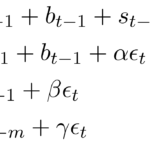While there is a lot to say about multistep losses, I’ve decided to write the final post on one of them and leave the topic alone for a while. Here it goes. Last time, we discussed MSEh and TMSE, and I mentioned that both of them impose shrinkage and have some advantages and disadvantages. One […]
ETS
Detecting patterns in white noise
Back in 2015, when I was working on my paper on Complex Exponential Smoothing, I conducted a simple simulation experiment to check how ARIMA and ETS select components/orders in time series. And I found something interesting… One of the important steps in forecasting with statistical models is identifying the existing structure. In the case of […]
What does “lower error measure” really mean?
“My amazing forecasting method has a lower MASE than any other method!” You’ve probably seen claims like this on social media or in papers. But have you ever thought about what it really means? Many forecasting experiments come to applying several approaches to a dataset, calculating error measures for each method per time series and […]
The role of M competitions in forecasting
If you are interested in forecasting, you might have heard of M-competitions. They played a pivotal role in developing forecasting principles, yet also sparked controversy. In this short post, I’ll briefly explain their historical significance and discuss their main findings. Before M-competitions, only few papers properly evaluated forecasting approaches. Statisticians assumed that if a model […]
Why you should not use Holt-Winters method
Whenever I see results of an experiment that include Holt-Winters method, I shrug. You should not use it, and here is why. Holt-Winters was developed in 1960 by a student of Charles Holt, Peter Winters (Winters, 1960). He extended Holt’s exponential smoothing method (the method that introduced a trend component) to include a seasonal component. […]
Staying Positive: Challenges and Solutions in Using Pure Multiplicative ETS Models
Authors: Ivan Svetunkov, John E. Boylan Journal: IMA Journal of Management Mathematics Abstract: Exponential smoothing in state space form (ETS) is a popular forecasting technique, widely used in research and practice. While the additive error ETS models have been well studied, the multiplicative error ones have received much less attention in forecasting literature. Still, these […]
Why you should care about Exponential Smoothing

On 15th December 2023, I presented in a CMAF Friday Forecasting Talks webinar on the topic of “Why you should care about exponential smoothing”. The motivation was to give a fresh view on the good old model and show how it started, how it evolved over time and how it can be improved. With this […]
iETS: State space model for intermittent demand forecasting
Authors: Ivan Svetunkov, John E. Boylan Journal: International Journal of Production Economics Abstract: Inventory decisions relating to items that are demanded intermittently are particularly challenging. Decisions relating to termination of sales of product often rely on point estimates of the mean demand, whereas replenishment decisions depend on quantiles from interval estimates. It is in this […]
Multi-step Estimators and Shrinkage Effect in Time Series Models
Authors: Ivan Svetunkov, Nikos Kourentzes, Rebecca Killick Journal: Computational Statistics Abstract: Many modern statistical models are used for both insight and prediction when applied to data. When models are used for prediction one should optimise parameters through a prediction error loss function. Estimation methods based on multiple steps ahead forecast errors have been shown to […]
Story of “Probabilistic forecasting of hourly emergency department arrivals”
The paper Back in 2020, when we were all siting in the COVID lockdown, I had a call with Bahman Rostami-Tabar to discuss one of our projects. He told me that he had an hourly data of an Emergency Department from a hospital in Wales, and suggested writing a paper for a healthcare audience to […]


